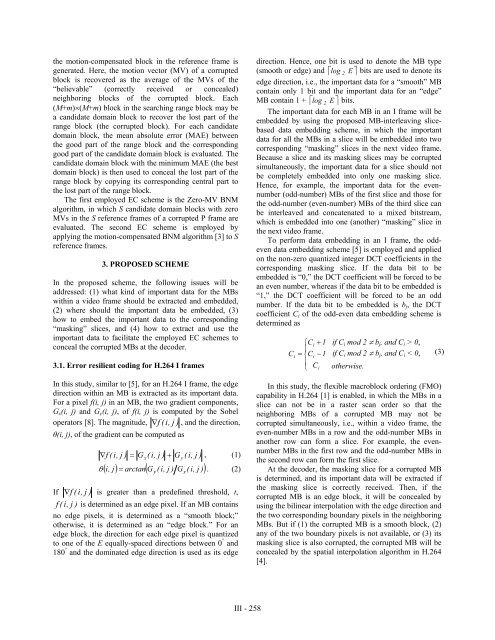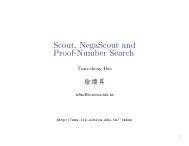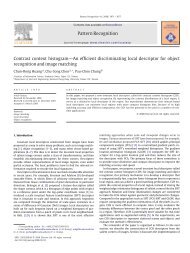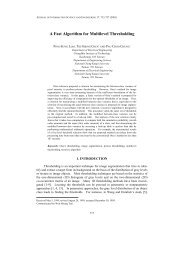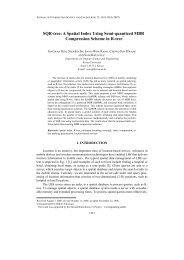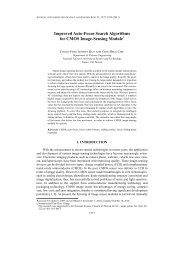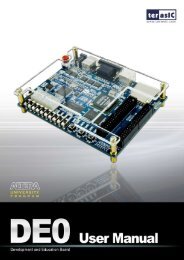An error resilient coding scheme for H.264 video transmission based ...
An error resilient coding scheme for H.264 video transmission based ...
An error resilient coding scheme for H.264 video transmission based ...
Create successful ePaper yourself
Turn your PDF publications into a flip-book with our unique Google optimized e-Paper software.
the motion-compensated block in the reference frame is<br />
generated. Here, the motion vector (MV) of a corrupted<br />
block is recovered as the average of the MVs of the<br />
“believable” (correctly received or concealed)<br />
neighboring blocks of the corrupted block. Each<br />
(M+m)(M+m) block in the searching range block may be<br />
a candidate domain block to recover the lost part of the<br />
range block (the corrupted block). For each candidate<br />
domain block, the mean absolute <strong>error</strong> (MAE) between<br />
the good part of the range block and the corresponding<br />
good part of the candidate domain block is evaluated. The<br />
candidate domain block with the minimum MAE (the best<br />
domain block) is then used to conceal the lost part of the<br />
range block by copying its corresponding central part to<br />
the lost part of the range block.<br />
The first employed EC <strong>scheme</strong> is the Zero-MV BNM<br />
algorithm, in which S candidate domain blocks with zero<br />
MVs in the S reference frames of a corrupted P frame are<br />
evaluated. The second EC <strong>scheme</strong> is employed by<br />
applying the motion-compensated BNM algorithm [3] to S<br />
reference frames.<br />
3. PROPOSED SCHEME<br />
In the proposed <strong>scheme</strong>, the following issues will be<br />
addressed: (1) what kind of important data <strong>for</strong> the MBs<br />
within a <strong>video</strong> frame should be extracted and embedded,<br />
(2) where should the important data be embedded, (3)<br />
how to embed the important data to the corresponding<br />
“masking” slices, and (4) how to extract and use the<br />
important data to facilitate the employed EC <strong>scheme</strong>s to<br />
conceal the corrupted MBs at the decoder.<br />
3.1. Error <strong>resilient</strong> <strong>coding</strong> <strong>for</strong> <strong>H.264</strong> I frames<br />
In this study, similar to [5], <strong>for</strong> an <strong>H.264</strong> I frame, the edge<br />
direction within an MB is extracted as its important data.<br />
For a pixel f(i, j) in an MB, the two gradient components,<br />
Gx(i, j) and Gy(i, j), of f(i, j) is computed by the Sobel<br />
operators [8]. The magnitude, f ( i,<br />
j ) , and the direction,<br />
(i, j), of the gradient can be computed as<br />
( i,<br />
j ) G ( i,<br />
j ) G ( i,<br />
j ) , (1)<br />
f x<br />
y<br />
, jarctanG<br />
( i,<br />
j ) G ( i,<br />
j ) <br />
. (2)<br />
i y x<br />
If f ( i,<br />
j ) is greater than a predefined threshold, t,<br />
f ( i,<br />
j ) is determined as an edge pixel. If an MB contains<br />
no edge pixels, it is determined as a “smooth block;”<br />
otherwise, it is determined as an “edge block.” For an<br />
edge block, the direction <strong>for</strong> each edge pixel is quantized<br />
to one of the E equally-spaced directions between 0 ° and<br />
180 ° and the dominated edge direction is used as its edge<br />
<br />
direction. Hence, one bit is used to denote the MB type<br />
(smooth or edge) and log 2 E bits are used to denote its<br />
edge direction, i.e., the important data <strong>for</strong> a “smooth” MB<br />
contain only 1 bit and the important data <strong>for</strong> an “edge”<br />
MB contain 1 + log 2 E bits.<br />
The important data <strong>for</strong> each MB in an I frame will be<br />
embedded by using the proposed MB-interleaving slice<strong>based</strong><br />
data embedding <strong>scheme</strong>, in which the important<br />
data <strong>for</strong> all the MBs in a slice will be embedded into two<br />
corresponding “masking” slices in the next <strong>video</strong> frame.<br />
Because a slice and its masking slices may be corrupted<br />
simultaneously, the important data <strong>for</strong> a slice should not<br />
be completely embedded into only one masking slice.<br />
Hence, <strong>for</strong> example, the important data <strong>for</strong> the evennumber<br />
(odd-number) MBs of the first slice and those <strong>for</strong><br />
the odd-number (even-number) MBs of the third slice can<br />
be interleaved and concatenated to a mixed bitstream,<br />
which is embedded into one (another) “masking” slice in<br />
the next <strong>video</strong> frame.<br />
To per<strong>for</strong>m data embedding in an I frame, the oddeven<br />
data embedding <strong>scheme</strong> [5] is employed and applied<br />
on the non-zero quantized integer DCT coefficients in the<br />
corresponding masking slice. If the data bit to be<br />
embedded is “0,” the DCT coefficient will be <strong>for</strong>ced to be<br />
an even number, whereas if the data bit to be embedded is<br />
“1,” the DCT coefficient will be <strong>for</strong>ced to be an odd<br />
number. If the data bit to be embedded is bj, the DCT<br />
coefficient Ci of the odd-even data embedding <strong>scheme</strong> is<br />
determined as<br />
if Ci mod 2 bj, and Ci > 0,<br />
Ci<br />
1<br />
<br />
C i Ci<br />
1 if Ci mod 2 bj, and Ci < 0, (3)<br />
<br />
Ci<br />
otherwise.<br />
In this study, the flexible macroblock ordering (FMO)<br />
capability in <strong>H.264</strong> [1] is enabled, in which the MBs in a<br />
slice can not be in a raster scan order so that the<br />
neighboring MBs of a corrupted MB may not be<br />
corrupted simultaneously, i.e., within a <strong>video</strong> frame, the<br />
even-number MBs in a row and the odd-number MBs in<br />
another row can <strong>for</strong>m a slice. For example, the evennumber<br />
MBs in the first row and the odd-number MBs in<br />
the second row can <strong>for</strong>m the first slice.<br />
At the decoder, the masking slice <strong>for</strong> a corrupted MB<br />
is determined, and its important data will be extracted if<br />
the masking slice is correctly received. Then, if the<br />
corrupted MB is an edge block, it will be concealed by<br />
using the bilinear interpolation with the edge direction and<br />
the two corresponding boundary pixels in the neighboring<br />
MBs. But if (1) the corrupted MB is a smooth block, (2)<br />
any of the two boundary pixels is not available, or (3) its<br />
masking slice is also corrupted, the corrupted MB will be<br />
concealed by the spatial interpolation algorithm in <strong>H.264</strong><br />
[4].


